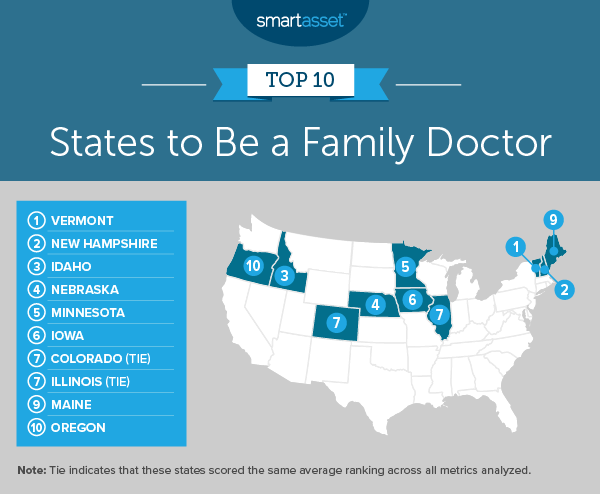
Family and general practitioners cover the primary care needs of many people in the U.S. and generally serve as the first point of contact for patients seeking medical help. While family and general practitioners focus on a wide range of preventative health measures such as healthy eating and regular exercise, they also diagnose and treat a multitude of sicknesses and injuries. Additionally, should patients require more intensive or extended care, family and general practitioners may refer them to specialists.
Though these doctors are an important first line of defense against illness, the number of family and general practitioners varies greatly by state. In raw Bureau of Labor Statistics totals from 2018, Florida had 12,870 family and general practitioners, the most of any state; by contrast, West Virginia had the least, at just 100. And in the number of family and general practitioners relative to total workers, there is quite a disparity as well. Vermont had 1.89 family and practitioners per 1,000 workers, the highest number of any state, compared to 0.14 in West Virginia, the lowest. Though it is clear that family and general practitioners are currently choosing not to move to or work in West Virginia based on the above statistics, it is less immediately evident which states may be some of the best places for family doctors.
In this study, SmartAsset looked at the best states for family doctors according to eight metrics that span job-specific data to home affordability and medically related community demographics. They include the number of family and general practitioners per 1,000 workers, average annual income, five-year earnings and job growth, median home value, percentage of the population without health insurance, percentage of residents getting sufficient physical activity and the number of medical facilities per 1,000 residents. For details about data sources and how we put all the information together to create our final rankings, check out the Data and Methodology section below.
Key Findings
- The Midwest is a healthy place for family doctors. Four of the states in our top 10 are in the Midwest. They include Nebraska, Minnesota, Iowa and Illinois.
- Variable job growth. Job growth for family and general practitioners has varied significantly across states over the past five years. Between 2014 and 2018, the number of family and general practitioners in Illinois increased by 138.62%, while it decreased in West Virginia by 77.27%.

1. Vermont
Vermont has a high concentration of family and general practitioners, and they serve population that is generally healthy. According to Census estimates, in 2018 there were 1.89 family and general practitioners per 1,000 workers, the most of any state in our study. Additionally, only 3.70% of the population doesn’t have health insurance, and 81.43% of residents participate in regular physical activity.
Five-year job and earnings growth in Vermont for family and general practitioners is also high. Between 2014 and 2018, the state saw a 41.46% increase in family and general practitioners, whose average annual earnings in that time period increased by 49.33%.
2. New Hampshire
In 2018, family and general practitioners in New Hampshire had the highest average annual income – $264,470 – relative to any other state. In comparison, the national average annual income for family and general practitioners was $211,780, about $53,000 lower. Family and general practitioners in New Hampshire have also seen the second-highest job growth of any state over the past five years. In 2014, there were 570 family and general practitioners in New Hampshire, and in 2018, there were 970, an increase of 70.18%.
Relative to Vermont, New Hampshire has a slightly higher uninsured population. According to 2019 data from countyhealthranking.com, 5.81% of the state’s population is uninsured. While its unemployment rate higher than Vermont’s, New Hampshire still places in the top half of all states for this metric, ranking 17th.
3. Idaho
Like New Hampshire, Idaho has had impressive job growth for family and general practitioners in recent years. The Granite State had 640 family doctors in 2014 but 990 in 2018, a 54.69% increase. Unfortunately, Idaho has the largest uninsured population of any state in our top 10. According to 2019 data from countyhealthranking.com, 9.62% of the population is uninsured.
4. Nebraska
Nebraska has strong employment numbers for family and general practitioners. In 2018, there were 1.61 family and general practitioners per 1,000 workers. That number is a result of recent growth. Between 2014 and 2018, the number of family and general practitioners in Nebraska increased by 40.18%, the fifth-highest rate for this metric in our study. Unfortunately, Nebraska lags a bit in health-related statistics compared to most other states in our top 10. About 8.02% of the population is uninsured, and 78.11% of residents participate in regular physical activity. The state ranks 27th and 24th overall for these metrics, respectively. This may be less attractive to family doctors who are looking to serve communities where there is a strong emphasis on preventative health measures.
5. Minnesota
In contrast to Nebraska, Minnesota has the second-highest health insurance rate of any Midwestern state in our top 10. An impressive 96.05% of the population has health insurance coverage, meaning that only 3.95% of residents are without coverage.
Minnesota lags compared to other Midwestern states in our top 10 in terms of affordability, specifically housing affordability. Median home values in Minnesota are the highest of any Midwestern state in our top 10. In 2018, the median home value in Minnesota was $224,000. In comparison, median home values in Nebraska, Iowa and Illinois were $155,800, $149,100 and $195,300, respectively.
6. Iowa
Iowa is a great place for family doctors who wish to raise families themselves. In our 2019 study on the best places for children, the metro areas of Cedar Rapids and Des Moines-West Des Moines in Iowa as well as Davenport-Moline-Rock Island in Iowa-Illinois ranked first, fourth and fifth, respectively. Iowa has the lowest median home value and the third-lowest percentage of uninsured residents of any state in our top 10. In 2018, the median home in Iowa was valued at $149,100, and in 2019, only 4.03% of the population did not have health insurance coverage.
7. Colorado (Tie)
Residents in Colorado are generally active, a fact that can improve their physical fitness and health. Data from countyhealthranking.com shows that 85.95% of residents get sufficient physical activity in Colorado, the highest rate of any state in our study. Unfortunately, home values in Colorado tend to be more than in all other states in our top 10, which may deter cost-conscious physicians from moving there. In 2018, the median home value in Colorado was $348,900, the fifth-highest amount of any state included in this study.
7. Illinois (Tie)
One important factor for doctors choosing a place to live is recent job growth. Job growth is an important indicator of the availability of new positions for doctors looking for work, as well as an indicator of job security for currently employed physicians. Illinois had the greatest percentage job growth in our study for family and general practitioners between 2014 and 2018. In 2014, there were only 3,340 family and general practitioners in the state, but over five years, that number grew to 7,970 – an increase of 138.62%. Additionally, compared to total workers, there were 1.33 family doctors per 1,000 workers in Illinois in 2018, the ninth-highest rate for this metric across all states in our study.
9. Maine
Maine has the second-highest number of medical facilities per 1,000 residents of any state in our study, meaning that there is a wide range of options for patients seeking care. This is good news for family and general practitioners as it suggests that they might not be overloaded with patients. However, Maine’s family and general practitioners are generally paid less as well. Average annual incomes for family and general practitioners in Maine are the lowest of any state in our top 10, ranking 36th overall. In 2018, the average annual income for family and general practitioners in the state was $202,440.
10. Oregon
Oregon is the only state in our top 10 with a negative job growth for family doctors over the past five years. In 2014, there were 1,440 family and general practitioners in the state and in 2018, there were 1,120, a decrease of 22.22%. Despite this decrease, Oregon does have a large number of places where family or general practitioners could potentially work. Using data from the 2016 Business Patterns Survey, we found that there are 3.28 medical facilities per every 1,000 residents in the state. Additionally, earnings growth for family doctors in Oregon has picked up recently. Between 2014 and 2018, the average annual income for family and general practitioners rose by 23.59%.

Data and Methodology
In order to find the best states to be a family doctor, SmartAsset looked at data for 47 states – excluding Georgia, North Dakota and Wisconsin due to insufficient data – along with the District of Columbia. Specifically, we compared the 47 states and the District of Columbia across the following eight metrics:
- Family and general practitioners per 1,000 workers. This is the number of family and general practitioners per 1,000 full-time workers. Data comes from the Bureau of Labor Statistics and is for 2018.
- Average income. This is the average annual income for family and general practitioners. Data comes from the Bureau of Labor Statistics and is for 2018.
- Five-year income growth. This is the percentage increase in average incomes for family and general practitioners between 2014 and 2018. Data comes from the Bureau of Labor Statistics.
- Five-year employment growth. This is the percentage increase in numbers of employed family and general practitioners between 2014 and 2018. Data comes from the Bureau of Labor Statistics.
- Median home value. Data comes from the Census Bureau’s 2017 1-year American Community Survey.
- Percent of population without health insurance. Data is from countyhealthranking.com for 2019.
- Percent of residents getting sufficient physical activity. Data is from countyhealthranking.com and is for 2019.
- Medical facilities per 1,000 residents. Data comes from the Census Bureau’s County Business Patterns Survey and is for 2016.
To create our final score, we ranked each state in each metric. Then we found each state’s average ranking, giving equal weight to all metrics. We used this average ranking to create our final score. The state with the best average ranking received a 100. The state with the worst average ranking received a 0.
Tips for Saving for Retirement
- Invest early. Want to make a positive prognosis for your financial future? That requires early planning. By planning and saving early, you can take advantage of compound interest. Take a look at our investment calculator to see how your investment can grow over time.
- Trusted personal finance advice. Doctors may be experts in treating physical ailments, but even they need help when it comes to creating a healthy financial future. A financial advisor can help clients make smarter financial decisions. Finding the right financial advisor that fits your needs doesn’t have to be hard. SmartAsset’s free tool matches you with financial advisors in your area in 5 minutes. If you’re ready to be matched with local advisors that will help you achieve your financial goals, get started now.
Questions about our study? Contact us at press@smartasset.com
Photo credit: ©iStock.com/sturti